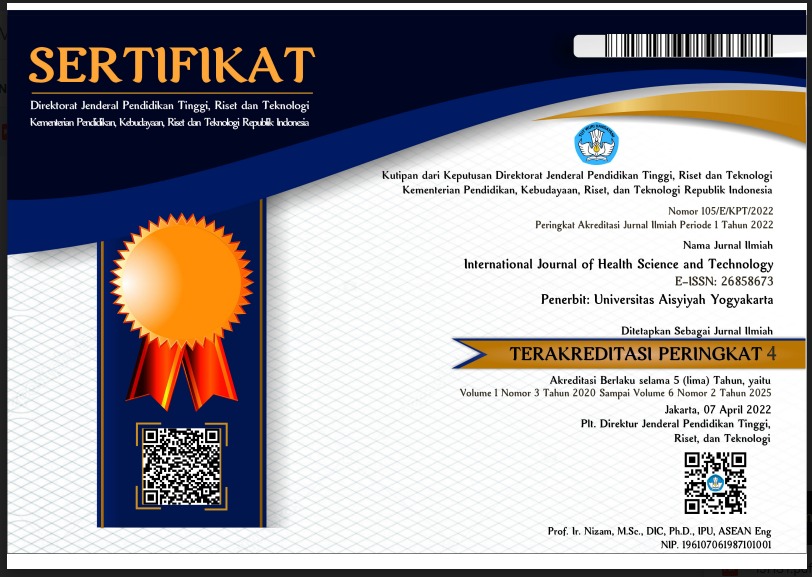The characteristics of mothers and stunted children in Kricak, Tegalrejo, Yogyakarta
DOI:
https://doi.org/10.31101/ijhst.v1i3.1201Abstract views 1338 times
Keywords:
stunting, children, nutritionAbstract
References
Abuya, B. A., Ciera, J., & Kimani-Murage, E. (2012). Effect of mother’s education on child’s nutritional status in the slums of Nairobi. BMC Pediatrics, 12, 80. http://doi.org/10.1186/1471-2431-12-80.
Akombi, B. J., Agho, K. E., Hall, J. J., Merom, D., Astell-Burt, T., & Renzaho, A. M. N. (2017). Stunting and severe stunting among children under-5 years in Nigeria: A multilevel analysis. BMC Pediatrics, 17, 15. http://doi.org/10.1186/s12887-016-0770-z
Bappenas dan UNICEF. (2013). Buletin 1 Periode Emas Pada 1000 Hari Pertama Kehidupan. BAPPENAS: Jakarta
Dinkes Yogyakarta. (2017), Profil Kesehatan Daerah Istimewa Yogyakarta, Dinkes Daerah Istimewa Yogyakarta, Yogyakarta
Dinas Kesehatan Kota D.I Yogyakarta. (2014). Peta Situasi Gizi DIY 2013. Yogyakarta: Seksi Gizi Dinkes DIY.
Kementerian Kesehatan Indonesia.(2016). Infodatin: Situasi Balita Pendek. Jakarta: Kementrian Kesehatan RI
Naik, R. and R. Smith. (2015). Impacts of Family Planning on Nutrition. Washington, DC: Futures Group, Health Policy Project. Diakses dari https://www.healthpolicyproject.com
Proverawati, A. & Asfuah, S. (2009). Buku Ajar Gizi untuk Kebidanan, Yogyakarta: Nuha Medika.
Shaaka, Mahama. (2014). Relationship between Mothers’ Nutritional Knowledge in Childcare Practices and the Growth of Children Living in Impoverished Rural Communities. NCBI. Diakses dari https://www.ncbi.nlm.nih.gov/pubmed/.
Shwatma, D. (2016). Analisis Faktor Risiko BBLR,Panjang Badan Bayi Saat Lahir dan Riwayat Imunisasi Dasar terhadap Kejadian Stunting pada Balita Usia 12-36 Bulan di Wilayah Kerja Puskesmas Kandai Kota kendari Tahun 2016. Jurnal Ilmiah Mahasiswa Kesehatan Masyarakat Volume 1 No 3. Diakses dari http://ojs.uho.ac.id/index.php/JIMKESMAS/article/view/1088
Welassih BD, Wirjatmadi RB. (2012). Beberapa Faktor yang Berhubungan dengan Status Gizi Balita Stunting. The Indonesian Journal of Public Health. 12: 8.
WHO. (2013). Childhood Stunting: Context, Causes and Consequences. WHO Conceptual Framework.
Downloads
Published
How to Cite
Issue
Section
License
International Journal of Health Science and Technology allows readers to read, download, copy, distribute, print, search, or link to its articles' full texts and allows readers to use them for any other lawful purpose. The journal allows the author(s) to hold the copyright without restrictions. Finally, the journal allows the author(s) to retain publishing rights without restrictions
- Authors are allowed to archive their submitted article in an open access repository
- Authors are allowed to archive the final published article in an open access repository with an acknowledgment of its initial publication in this journal

This work is licensed under a Creative Commons Attribution-ShareAlike 4.0 Generic License.










